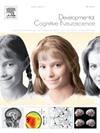Predictive coding and attention in developmental cognitive neuroscience and perspectives for neurodevelopmental disorders
IF 4.9
2区 医学
Q1 NEUROSCIENCES
引用次数: 0
Abstract
Sensory prediction and repetition suppression are closely related cognitive mechanisms that allow the brain to form predictions about the environment, and guide perception in synergy with attention. Predictive coding is a theory of the fundamental role of predictive mechanisms in brain functions. Authors have proposed a central role of predictive impairments in autism and possibly other neurodevelopmental disorders. However, little is known about predictive mechanisms in typical development, and how they co-develop with attention. Here we review experimental support for predictive coding and its links with attention in healthy adults’ brains, the first experimental works performed in typically developing children and infants, and theoretical accounts of neurodevelopmental disorders using a predictive coding framework. We propose future directions for predictive coding research in development. Finally, we describe the first predictive coding experiments in neonates and provide research perspectives for using this framework in searching for early markers of atypical neurodevelopment.
发育认知神经科学中的预测编码和注意以及神经发育障碍的观点。
感觉预测和重复抑制是密切相关的认知机制,使大脑形成对环境的预测,并引导感知与注意协同作用。预测编码是关于预测机制在脑功能中的基本作用的理论。作者提出了自闭症和其他可能的神经发育障碍的预测性损伤的核心作用。然而,关于典型发育的预测机制,以及它们如何与注意力共同发展,我们知之甚少。在这里,我们回顾了预测编码的实验支持及其与健康成人大脑注意力的联系,在正常发育的儿童和婴儿中进行的第一次实验工作,以及使用预测编码框架对神经发育障碍的理论解释。展望了未来预测编码研究的发展方向。最后,我们描述了在新生儿中进行的第一个预测编码实验,并为使用该框架寻找非典型神经发育的早期标记提供了研究视角。
本文章由计算机程序翻译,如有差异,请以英文原文为准。
求助全文
约1分钟内获得全文
求助全文
来源期刊

Developmental Cognitive Neuroscience
NEUROSCIENCES-
CiteScore
7.60
自引率
10.60%
发文量
124
审稿时长
6-12 weeks
期刊介绍:
The journal publishes theoretical and research papers on cognitive brain development, from infancy through childhood and adolescence and into adulthood. It covers neurocognitive development and neurocognitive processing in both typical and atypical development, including social and affective aspects. Appropriate methodologies for the journal include, but are not limited to, functional neuroimaging (fMRI and MEG), electrophysiology (EEG and ERP), NIRS and transcranial magnetic stimulation, as well as other basic neuroscience approaches using cellular and animal models that directly address cognitive brain development, patient studies, case studies, post-mortem studies and pharmacological studies.
 求助内容:
求助内容: 应助结果提醒方式:
应助结果提醒方式:


